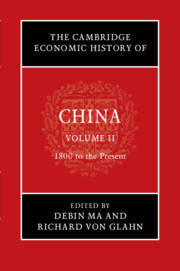Book contents
- The Cambridge Economic History of China
- The Cambridge Economic History of China
- The Cambridge Economic History of China
- Copyright page
- Contents
- Figures
- Maps
- Tables
- Contributors to Volume II
- Acknowledgments
- Note on Citations
- Introduction to Volume II
- Part I 1800–1950
- 1 Ideology and the Contours of Economic Change
- 2 Economic Transition in the Nineteenth Century
- 3 Agriculture
- 4 Handicraft and Modern Industries
- 5 The State and Enterprises in Late Qing China
- 6 State Enterprises during the First Half of the Twentieth Century
- 7 Money and the Macro-economy
- 8 Public Finance
- 9 Financial Institutions and Financial Markets
- 10 Chinese Business Organization
- 11 The Economic Impact of the West
- 12 Foreign Trade and Investment
- 13 Transport and Communication Infrastructure
- 14 Education and Human Capital
- Part II 1950 to the Present
- Index
- References
10 - Chinese Business Organization
from Part I - 1800–1950
Published online by Cambridge University Press: 07 February 2022
- The Cambridge Economic History of China
- The Cambridge Economic History of China
- The Cambridge Economic History of China
- Copyright page
- Contents
- Figures
- Maps
- Tables
- Contributors to Volume II
- Acknowledgments
- Note on Citations
- Introduction to Volume II
- Part I 1800–1950
- 1 Ideology and the Contours of Economic Change
- 2 Economic Transition in the Nineteenth Century
- 3 Agriculture
- 4 Handicraft and Modern Industries
- 5 The State and Enterprises in Late Qing China
- 6 State Enterprises during the First Half of the Twentieth Century
- 7 Money and the Macro-economy
- 8 Public Finance
- 9 Financial Institutions and Financial Markets
- 10 Chinese Business Organization
- 11 The Economic Impact of the West
- 12 Foreign Trade and Investment
- 13 Transport and Communication Infrastructure
- 14 Education and Human Capital
- Part II 1950 to the Present
- Index
- References
Summary
In this chapter we will examine how key institutions were mobilized to shape China’s early modern business practices under weak state engagement of the economy, and a growing foreign presence. Business practices in the late imperial period rested on four pillars, each a fundamental part of the institutional framework that structured social and economic life. The first, family, provided templates for the utilization of capital and labor and the mobilization of trust, tools that proved as useful for China’s late imperial commercial economy as for the early modern economy of industrial enterprise and global engagement. The second might be termed the system of private ordering that served generations of Chinese merchants and others in combining capital and establishing the terms of economic interaction, often through written contracts whose provisions established highly flexible forms of partnership that continued to form the basis of most Chinese business until the early PRC. The third, native place, in significant ways mirrored the intangible assets provided by ties of kinship, offering a predetermined basis for co-operation, nurturing and protecting group interests and skills and, like the fourth, grounding these intangibles in very tangible organizations catering to inhabitants of a particular city, region, or province.
Keywords
- Type
- Chapter
- Information
- The Cambridge Economic History of China , pp. 324 - 353Publisher: Cambridge University PressPrint publication year: 2022



